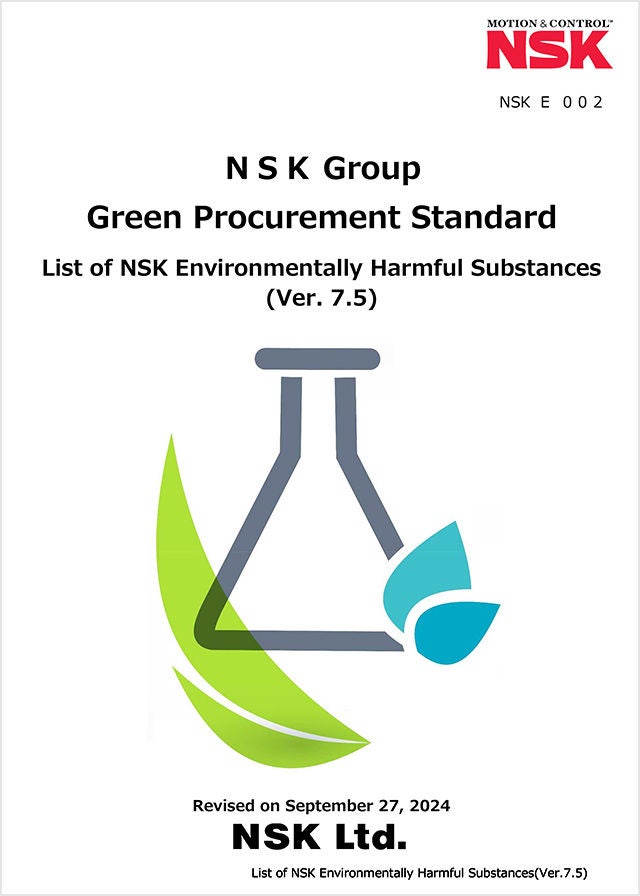Reducing Use of Environmentally Harmful Substances
NSK’s Approach
The NSK Group strives to create products that use no environmentally harmful substances.*1 We use the NSK List of Environmentally Harmful Substances to rigorously control and reduce environmentally harmful substances in each stage of development and design, procurement, manufacturing, and distribution. The List is based on industry standards such as the EU RoHS2 Directive,*2 the EU REACH*3 and SVHC,*4 and GADSL.*5 We set and adhere to discretionary standards that are more rigorous than regulations for safeguarding air and water quality from exhaust gas and wastewater generated by production processes. In addition, we press suppliers to practice rigorous management based on the NSK Group Green Procurement Standards and the NSK List of Environmentally Harmful Substances.
*1 Substances that impede preservation of the environment (including ecosystems) or maintaining good health, as well as substances which may have the potential to do so.
*2 RoHS2 is an update for the original "Directive on the Restriction of Certain Hazardous Substances in Electrical and Electronic Equipment" that restricts the use of certain harmful materials in electric and electronic devices distributed in the EU. Currently, 10 substances such as phthalates are regulated.
*3 Registration, Evaluation, Authorization, and Restriction of Chemicals: A comprehensive chemical substance regulation system that came into force in the EU in June 2007.
*4 Substances of Very High Concern: A list of candidates for inclusion under EU REACH.
*5 Global Automotive Declarable Substance List: A list of environmentally harmful substances compiled by consensus of automobile-related manufacturers around the world.
System
To reduce the environmental impact of the entire value chain, the NSK Group maintains a system for managing environmentally harmful substances. We develop rules for the management of environmentally harmful substances in accordance with laws, regulations, and industry standards related to the chemical substances that must be managed.
Management of Environmentally Harmful Substances
Targets and Performance
◆Mid-Term Management Plan 2026 (MTP2026) Targets, with Targets and Performance for Each Fiscal Year
| MTP2026 | FY2023 Targets | FY2023 Performance | Initiatives | FY2024 Targets | |
|---|---|---|---|---|---|
Development and design, procurement, and manufacturing | Full response to the 10 EU RoHS2 substances | Full response to EU RoHS2 | Continued efforts to completely eliminate environmentally hazardous substances from developed products and manufacturing processes |
| Full response to EU RoHS2 |
| Procurement | Conduct survey regarding inclusion of substances on the NSK List of Environmentally Harmful Substances | Conduct supplier audits of the management systems for environmentally harmful substances | Continued to conduct supplier audits and take corrective actions |
| Conduct supplier audits of the management systems for environmentally harmful substances |
Obtain responses from all target suppliers | Continued to obtain responses from all target suppliers |
| Obtain responses from all target suppliers | ||
| Manufacturing (Japan) | Handling of PRTR-designated substances per unit of sales: Continue to reduce by 1% year on year | Below -1% (base year FY2022) | +0.4% (base year FY2022) |
| Below -1% (base year FY2023) |
Initiatives
◆Initiatives in Procurement, Design, Manufacturing, and All Processes That Involve Customers
Green Procurement and Management of Environmentally Harmful Substances
The NSK Group has included environmentally harmful substances identified based on laws, regulations, and industry standards on the NSK List of Environmentally Harmful Substances.* Additionally, we established the NSK Group Green Procurement Standards to prevent the delivery of products with prohibited substances. We ask our suppliers to practice thorough management and to maintain and improve their management systems. We organize green procurement briefings around the world and kindly request the submission of consent forms. Additionally, we conduct audits of our major suppliers, and if any issues are found, we promptly ask for corrective actions and follow up on the improvement progress.
NSK customers all around the world use our products. This is why products that contain NSK components must not only comply with laws and regulations worldwide, but also with environmentally harmful substance standards in the automotive, electrical, and electronic industries. Every year, the NSK Group surveys its suppliers based on the NSK List of Environmentally Harmful Substances. We also respond swiftly to requests for information on environmentally harmful substances from our customers.
* A list classifying environmentally harmful substances as “prohibited” (substances that must not be included in or with delivered products), “reduced” (substances that will be reduced systematically), or “under observation” (substances whose inclusion must be monitored).
◆Initiatives in Design and Production Processes
Full Response to the 10 EU RoHS2 Substances
Based on the results of supplier surveys, the NSK Group has created a list of parts confirmed to not contain the 10 substances prohibited under the EU RoHS2 Directive. We confirm that prohibited substances are not included when designing products. The list is also used at each plant when receiving procured parts. Phthalates have been added to the EU RoHS2 Directive. Phthalates have a high migration potential—that is, they move easily through contact. For this reason, we do more than disallow them in product materials; we also conduct global surveys of resins, rubber gloves, packaging, and other materials that our products come into contact with during manufacturing processes. This ongoing initiative aims to eliminate the risk of phthalates migrating to our products during manufacturing.


